Rocketdyne’s earthquake rift transports toxins down into Runkle Canyon
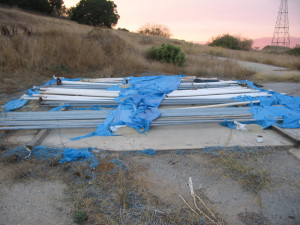
EnviroReporter.com – October 20, 2009
The mystery of Runkle Canyon Creek’s heavy metal soil and water contamination may be simple to a fault – the Burro Flats Fault to be exact. The earthquake rift runs the length of the former Rocketdyne lab, east to west, and dips into Runkle Canyon and turns north into the city of Simi Valley.
The Burro Flats Fault which sculpted this beautiful land of vernal pools and soaring cliffs may also be the main path that pollutants have found their way down into Runkle Canyon where a citizens group called the Radiation Rangers discovered arsenic, nickel, vanadium and other poisonous metals in the creek water and soil in 2007. The results were subsequently verified by city sampling and tests.
EnviroReporter.com has uncovered evidence that suggests that a Cold War era facility at the neighboring Santa Susana Field Laboratory (SSFL), and an adjacent chemical dump, could be the source of Runkle Canyon creek’s heavy metal pollution. Thousands of pages of documents about the site, located in the former nuclear research “Area IV” of the 2,850-acre lab and which sits on top of the Burro Flats Fault, reveal extensive contamination.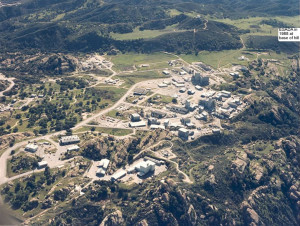
Recent studies at the proposed nuclear repository at Yucca Mountain, Nevada and at the Department of Energy-funded Lawrence Livermore National Laboratory have shown that contaminants readily flow down and through earthquake faults. In 2005, the late former state geologist under Governor Reagan, Jim Slosson, confirmed to EnviroReporter.com that the faults in this specific area of the lab were transporting groundwater goo offsite.
The Empire State Atomic Development Authority, or ESADA, sat in the westernmost corner of Area IV of Boeing’s lab on 1.5 acres. The dismantled site is undergoing a costly remediation for a host of toxic waste including arsenic, vanadium, boron, glycol ethers and Dowanol-PM that was used to clean piping and components at the infamous Sodium Reactor Experiment or SRE.
Hundreds of leaking barrels of chemicals have been removed from the unsecured site near an open gate leading to Runkle Canyon. Piping covered by ripped tarps litters the deserted foundations of the ESADA, perhaps the same pipes used to blow apart testing tolerances for use in the SRE.
Late last year, hardware from the contaminated facility was also found outside of the lab perimeter (Image 0036) by EnviroReporter.com in the highlands above Runkle Canyon. Offsite dumping like this, along with the discovery of the contamination connection along the fault line, doesn’t surprise one of Radiation Rangers.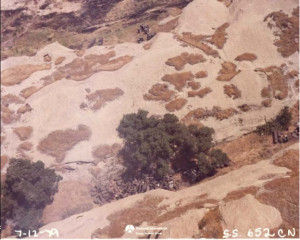
“We’ve always figured that this stuff was coming down the hill from Rocketdyne,” says the Reverend John Southwick. “But now we know from where and how it got here. That’s astonishing. But I’m not surprised that no one has put goo and goo together considering Boeing doesn’t want to be on the hook for any contaminants on KB Home property and KB is determined to develop downhill from a place that had meltdowns.”
There were ten nuclear reactors in Area IV. Six had major accidents including the Sodium Reactor Experiment which melted down in 1959 spewing, by some estimates, hundreds of times more radiation from the uncontained reactor building than the more infamous Three Mile Island meltdown did twenty years later.
The lasting effects of radiological and chemical contamination at Area IV, and the surrounding communities, are still present today and this section of SSFL is undergoing a characterization and cleanup that will cost hundreds of millions and take until at least 2017. Huge fines have been assessed the company that now owns the site, Boeing, for contaminated offsite discharges into the headwaters of the Los Angeles River, where most of Area IV drains to as well.
The Department of Energy, or DOE, which is responsible for the cleanup of the 90-acre Energy Technology Engineering Center (ETEC) in Area IV, estimates that the final cost of remediating ETEC will be between $167.9 million to $221.4 million.
Southwick is concerned that the current Runkle Canyon “draft Response Plan” currently proposed by developer KB Home to clean up the 1,595-acre property, has nothing in it about this possible source of chemicals coming down the creek. The plan is a result of an agreement last year between KB Home and the Department of Toxic Substances Control (DTSC), which is in charge of investigating the canyon’s environmental conditions largely in reaction to public uproar over Runkle Canyon revelations of heightened strontium-90 readings in site soil. In August, the department replaced its Project Manager for the Runkle Canyon and Rocketdyne cleanups, Norman E. Riley, and pledged to toughen up its oversight.
The current plan includes no retesting of the creek and determining the source of the pollution which was found in even greater amounts by the city of Simi Valley a month after the Ranger’s findings made headlines. The Rangers, who maintain a website called StopRunkledyne.com, say that this new information about the ESADA’s contamination making its way down the Burro Flats Fault raises their concerns even more about possible development of Runkle Canyon.
“This new DTSC team couldn’t have come at a better time because they seem serious about making sure Runkle Canyon is safe for all the people that will go up there hiking and biking around thinking it’s okay,” Southwick says. “That whole area has to be tested for these toxins because it’s unsafe for humans and pets especially when the water’s flowing. And we’ve got to figure out how to turn off Rocketdyne’s toxic tap, as it were, because that water is coming down through Runkle Canyon to the Arroyo Simi and getting in the groundwater many of us drink.”
Southwick is hoping that discovery of a contamination connection between the lab and the canyon may persuade government officials to order the developer to complete a much more extensive toxic evaluation of the property before it is developed. KB Home has envisioned this part of its property as “open space” which would be accessible by new residents and the public. Southwick just hopes it isn’t too open.
“The more we learn about Runkle Canyon’s problems, which are now the city of Simi Valley’s problems because they annexed the place in 2006, the more we need to reconsider the idea of letting people up Runkle willy-nilly if and when it ever opens,” says Southwick. “The amount of toxins in the water could harm your pets, that’s for sure, and there should at least be signs saying ‘don’t touch the water’ and ‘visit this place at your own risk.’”
Empire State Atomic Development Authority
The ESADA sits atop the predominant earthquake rift running east to west at the sprawling former Rocketdyne facility. Heavy metal found in Runkle Canyon’s creek water and soil at high levels, including arsenic, vanadium and sodium, are also found at the 1.5 acre ESADA site but in much higher concentrations.
Not all facilities in the 270-acre Area IV of the SSFL were part of ETEC, which had ten reactors, a “hot lab” where nuclear power plant fuel rods from around the country were shipped after use in order to be cut apart, and a sodium burn pit, an unlined area filled with goo where barrels of radioactive sodium were tossed in and then set ablaze by workers choosing lots and firing a rifle at the canisters.
ESADA was one of those facilities outside of ETEC and the site closest to the headlands of Runkle Canyon which the lab has an 11-acre drainage down into KB Home property. The ESADA site was first operated by Atomics International, a division of North American Aviation, and later of Rockwell International which was bought by the Boeing Company in 1996.
Much of Rockwell International, along with Rocketdyne, was sold to Boeing in 1996 where it served as part of Boeing Integrated Defense Systems until its sale to Pratt & Whitney on August 2, 2005. That Pratt & Whitney purchase included all of Rocketdyne except the Santa Susana Field Laboratory land itself.
Five ESADA chemical use areas being evaluated for contamination include the former storage yard for the barrels of chemicals, former Process Development Unit, Aboveground Storage Tank, pistol range and the Sodium Test Area.
According to a 1964 Rockwell report, “Sodium-water tests were conducted at the Building 814 test structure. Building 814 was a large leak injector device (LLID), where heated sodium, high-pressure water, and steam flowed via tubes and piping to a test section to simulate tube failure in a sodium graphite reactor (SGR). To initiate the tests, discs that blocked the high-pressure water and steam lines from the test section were mechanically ruptured.”
Underground piping connected B814 to a concrete-lined pool just north of B886 at the intensely polluted Sodium Burn Pit. It is possible that the Burro Flats Fault helped transport leaked sodium down into Runkle Canyon which tests extremely high for the salt.
The ESADA concrete pool was utilized for cleaning alkali bearing components. In the late 1960s, the ESADA area was also used for drum storage and surrogate fuel pellet testing. It was called the ESADA Chemical Storage Yard and was used for the storage of more than 500 drums containing Dowanol-TM glycol ethers and ethanol, and an unspecified number of empty drums. Approximately 120 drums contained Dowanol-PM (propylene glycol methyl ether), which was nearly saturated with sodium.
The Dowanol-PM was used to clean piping and components at the Sodium Reactor Experiment. Over 400 of the drums contained denatured ethanol. The ethanol drums had varying concentrations of sodium, and some of them were known to have leaked.
The eastern ESADA area was used as pistol range and remains polluted with dangerous amounts of antimony, arsenic, boron, lead, and selenium. Aluminum, vanadium and, not surprisingly, sodium are also found in high concentrations. All ESADA buildings have been demolished.
Parts of the area are sandbagged forcing some surface water flow towards so-called Outfall 6 which leads down into the American Jewish University, Brandeis-Bardin Campus in western Simi Valley. There in Meier Canyon, which receives downhill Area IV runoff down multiple channels, signs nailed to oaks say “WARNING – DO NOT DRINK OR USE THIS WATER.”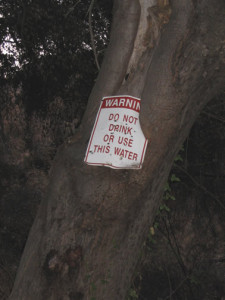
Between August 1988 and May 2007, 77 soil samples and 16 soil vapor samples were collected to assess potential impact associated with the chemical use areas at the ESADA, according to the 3,410 page Group 8 Western Portion of Area IV – Volume III Appendix C and D prepared for Boeing, dated September 2007. Two monitoring wells were used to specifically characterize ESADA groundwater.
The Process Development Unit was closely analyzed for volatile and semi-volatile organic compounds, polychlorinated biphenyls or PCBs, total petroleum hydrocarbons and heavy metals to “evaluate their presence due to the documented storage of ‘green liquor’ waste water, which contains organic compounds, sulfur compounds, and ash,” according to a 1993 report that made up part of the assessment. The 8,000 gallon tank for the green goo has been since removed.
The report’s high results were astounding though perhaps not surprising considering the plethora of pollution at the lab. Aluminum, sodium, and vanadium were detected above background concentrations at the ESADA’s former chemical storage yard with concentrations of aluminum and vanadium that exceeded ecological Risk Based Screening Levels, or RBSLs, but were less than human health RBSLs.
RBSLs are used by the U.S. Environmental Protection Agency to “help identify areas, contaminants, and conditions that require further federal attention at a particular site,” according to the agency. “They are risk-based concentrations derived from standardized equations combining exposure information assumptions with EPA toxicity data.”
Vanadium in the soil exceeded the background concentration at one ESADA location while “five metals, (antimony, arsenic, boron, lead, and selenium) exceeded background concentrations, residential RBSLs, and/or ecological RBSLs at the ESADA Pistol Range,” according to the 2007 study.
“The maximum concentration of antimony (up to 870 mg/kg), arsenic (up to 350 mg/kg), and lead (up to 27,000 mg/kg) were detected in samples collected in the target (i.e., south) area of the pistol range.”
ESADA antimony ranged up to 100 times background, arsenic over 23 times normal for the site and 9,000 times lab background for lead. Lead was also found at elevated levels in the groundwater. “Based on lead concentrations in soil, lead is potentially site-related in groundwater.”
“Organic chemicals above regulatory criteria include benzene, toluene, benzoic acid, bis(2-chloroethyl)ether, and gasoline-range hydrocarbons,” the report noted of the soil.
Making sense of these soaring numbers is complex but not impossible. A so-called Hazard Quotient (HQ) and Hazard Index (HI) are utilized to determine risk to humans and the environment including wildlife. “HQs are hazard estimates for single CPECs [Contaminant of Particular Ecological Concern], while HIs are cumulative hazard estimates for all CPECs,” the report reads. “For comparison purposes, HQ or HI values less than 1 represent conditions that would not cause unacceptable ecological impacts. HQ or HI values greater than 1 typically require additional evaluation, and may be deemed acceptable or unacceptable by risk managers.”
Kids don’t fair so well in the “Future Child Resident” scenario where they score a whopping twenty. Of course, the land is not supposed to be developed for residents after the cleanup so no children will live on the property. That the HI exceeded the child resident scenario by twenty times, though, is a significant indicator of the level of contamination at the ESADA site.
Animals do live at the lab and have easy access to the ESADA through the porous perimeter of the Santa Susana Field Laboratory. Additionally, there is an open gate leading to Runkle Canyon two hundred yards to the west of the ESADA. Critters might best stay away according to the beasts’ Hazard Index in the report.
“The deer mouse, thrush, hawk and mule deer have estimated HIs in excess of 1,000, while the bobcat has an estimated HI in excess of 100,” says the study. “These HIs are primarily associated with antimony, arsenic, lead, and selenium.”
All Downhill from Here
“The Burro Flats Fault, located in the southern part of the Group 8 Reporting Area, strikes approximately east-west in the vicinity of the ESADA RFI Site,” the study says citing two previous reports in 1992 and 2002. “Chatsworth formation groundwater flow is toward the northwest. Estimated horizontal gradients in the vicinity of the ESADA RFI Site are approximately 0.1 foot/foot, based on recent groundwater level measurements.”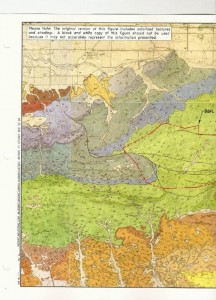
Northwest from this location leads to Runkle Canyon. But do contaminants travel down earthquake rifts like the Burro Flats Fault that curves into the canyon? Recent studies suggest so.
An April 2004 analysis, published in the Vadose Zone Journal, looked at Yucca Mountain, 80 miles northwest of the Las Vegas. It was the proposed site for the nation’s main nuclear waste repository from 1987 to 2009 when the project was killed partly over active earthquake faults and volcanoes but not before costing over $90 billion.
The report, “Development of a Wet Plume Following Liquid Release along a Fault,” was carried out “in situ” or at the actual Yucca Mountain site instead of a laboratory. The study’s conclusions don’t bode well for Runkle Canyon’s heavy metal dilemma.
“We observed that water (introduced along the fault) maintained the fault as the primary vertical flowpath, while the adjacent fractured rock served to move water laterally and vertically,” the study said.
A year later, the late Jim Slosson told this reporter in an interview that the fault lines in the western part of Santa Susana Field Laboratory are interconnected with those in adjacent Ahmanson Ranch, which abuts Runkle Canyon’s southern border. Slosson was quoted in a February 2005 Los Angeles CityBeat-ValleyBeat article called “Pipe Dreams”:
At issue is the interconnectivity between the Ahmanson aquifer and the heavily polluted groundwater underneath Rocketdyne’s lab. “They are definitely connected by way of faults, and the faults are significant as far as the groundwater migration,” says Jim Slosson, former state geologist under Governor Reagan and now chief engineering geologist for Slosson and Associates, his Van Nuys-based geology consulting firm. “I think that would be almost a stupid move because the greatest part of the contaminated aquifer in the Ahmanson Ranch area is in area immediately right up there by Burro Flats,” he said, referring to Rocketdyne’s radiological area, the site of a partial nuclear reactor meltdown in 1959 as well as numerous other nuclear accidents and mishaps.
Two years later, a comprehensive study of another site with chemical and nuclear contamination in an area riddled with faults came out and was called “Contaminant Plumes of the Lawrence Berkeley National Laboratory and the Interrelationship to faults, Landslides, and Streams in Strawberry Canyon, Oakland and Berkeley, California.”
The 55-page (128mb) March 2007 report was authored by Laurel Collins, a geomorphologist with Berkeley-based Watershed Sciences and Pamela Sihvola, Project Manager Committee to Minimize Toxic Waste. One map of the area, pictured here with its legend, shows “groundwater plume expansion along compiled faults.”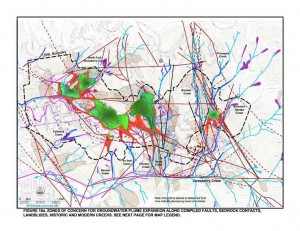
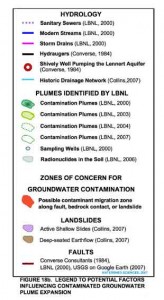
“[G]roundwater can transfer along any number of pathways (bedrock contacts, faults and landslide failure planes) and in any order of combination,” the report reads. “Furthermore, potential surface water contamination is possible along drainages that intersect faults, landsides, and bedrock contacts that intersect contaminant plumes.”
Collins and Sihvola make a recommendation that might seem appropriate in Runkle Canyon:
If the complexity of geologic conditions at the contamination sites has been and continues to be oversimplified, and because monitoring wells were not placed at key locations along faults, utility trenches, old creek beds/seeps and other parameters that influence groundwater movement, the extent and dispersement of contaminants may have been, and will continue to be underestimated in the future.
Currently, there are no monitoring wells for contamination from the ESADA along the Burro Flats Fault down into Runkle Canyon. Monitoring wells are nowhere to be found in the draft cleanup Response Plan for Runkle Canyon that the Department of Toxic Substances is looking at with “clean eyes,” as Acting Director Maziar Movassaghi told EnviroReporter.com in August as reported in “Coup de Goo.”
Strontium Storm on the Horizon?
When Los Angeles CityBeat and the Ventura County Reporter broke the Runkle Canyon development contamination story in March 2005, most of the emphasis was on the high strontium-90 soil readings in the developer’s environmental impact reports. This information was either missed or ignored by the city of Simi Valley the year before when it approved the 461-home project’s Environmental Impact Report, even though the readings were as high as hundreds of times normal as we reported:
Foster Wheeler’s 58 soil samples averaged 1.39 pCi/g, or six times the EPA’s preliminary remediation goal and nearly 27 times above the typical EPA background level for Sr-90 in the area. The hottest sampling spot, and the one closest to Rocketdyne’s Santa Susana Field Laboratory, measured 12.34 pCi/g, which is over 54 times the EPA’s PRG and 237 times the normal background for the radionuclide. Regardless, the GreenPark subcontractor gave a hearty thumbs-up to the results. “In perspective, the concentrations of strontium-90 … were found to be insignificant,” concluded the Foster Wheeler report.
“That’s definitely within the risk range,” says Walker, “unless something weird is going on with the site that would kick it up but, like I said, those are conservative numbers.”
“[Foster Wheeler] found even higher rad levels in the second set of tests than the first and had to massage them through really flaky means, but the numbers don’t lie,” says longtime Rocketdyne critic Dan Hirsch of the Santa Cruz-based Committee to Bridge the Gap.
Three months after our initial exposé broke, the then-called California Department of Health Service (CDHS) quietly took single samples from five highest reading areas for strontium-90 in Runkle Canyon. That June 7, 2005 test was reported on in the January 19, 2006 Los Angeles ValleyBeat article “Hot Property”:
The CDHS split these samples with Dade Moeller & Associates of Richland, Washington, a laboratory hired by the developer. “We only did those samples that the state was interested in because the state was the driver on this, of course,” said the lab’s point person on the sampling, Tracy Ikenberry. “They were the ones who wanted to do it.”
The results of the 2005 sampling were obtained by ValleyBeat through a Public Records Act request. They show the readings from Dade Moeller and from the CDHS state lab in Richmond. The retested locations were all radically lower in Sr-90 than in the previous tests conducted by GreenPark Runkle. In one spot tested, the state lab’s results were 490 times lower for Sr-90 than when it was tested in a 1999 survey. Oddly, the CDHS results for Sr-90 were from two-to-19 times less than the exact same split samples analyzed by Dade Moeller.
Those tests were eventually thrown out by the government in its evaluation of Runkle Canyon which was the result of a “Voluntary Cleanup Agreement” between KB Home and DTSC from early last year.
Dan Hirsch, who first alerted Los Angeles CityBeat/ValleyBeat and the Ventura County Reporter about the high strontium-90 in Runkle Canyon in late 2004, examined the radiation issue at the site in his December 2006 “Radioactive Contamination at Runkle Ranch from the Santa Susana Field Laboratory.”
In a February 2009 Ventura County Reporter piece called “‘Simi, we have a problem’,” Hirsch lambasted Dade Moeller qualifications to retest Runkle Canyon for KB Home as part of the cleanup Response Plan still being decided on by DTSC:
“‘Houston, we have a problem,’ which is what the city was told was not true,” Hirsch added. “The developer had not been candid and the entire project was approved based on false representation.”
Hirsch then zeroed in on Dade Moeller’s radiation plan and on the controversial company itself, whose namesake testified back in the 1990s that money spent on cleaning up Cold War-era nuclear facilities was being wasted since there would be a cure for cancer.
Hirsch also questioned the lab’s integrity and pointed out that it is a major Department of Energy (DOE) contractor. The area of Rocketdyne where most of the nuclear mishaps occurred was operated by the DOE, which is responsible for cleaning up the mess. It also borders Runkle Canyon, which leads Hirsch to believe that Dade Moeller shouldn’t be overseeing radiation sampling there.
The Rangers are glad that Dade Moeller’s credentials may get another looking over since the August sacking of Norm Riley, former DTSC Project Manager for Runkle Canyon. Riley, who the Rangers had increasingly asserted wasn’t addressing public concerns and comments about Runkle Canyon, made his feelings abundantly clear about Dade Moeller in his angry reply to an intercepted e-mail from this reporter to Rocketdyne activist Christina Walsh, who had secretly copied him without my permission. In it, as reported last month in “Riley’s Revenge,” Riley called Dade Moeller “one of the most highly respected firms in the business.”
Riley’s removal doesn’t distress the Rev. Southwick. “We now have the chance to undo all the bad science, or lack of science, we saw under Riley,” Southwick says. “The Response Plan simply has too few testing spots for strontium-90, working out to be just one for every thirteen acres, which is ridiculous on the face of it.”
Contamination Creek
The emphasis on Runkle Canyon’s strontium-90 impacted soil continues to be a major concern to the public today as reported in our “EnviroReporter.com’s Runkle Canyon Comments Analysis.”
In fact, it was this concern that inspired four Simi Valley citizens in 2006 to demand that no development of the property be started until there was a full accounting for the high radiation we first reported on. In good humor, they called themselves the “Radiation Rangers.”
“The city council attacked us as NIMBYs and troublemakers but most folks really appreciated what we started doing and never stopped doing which is making the developer and Boeing accountable to the facts,” says “Toxic Terry” Matheney, a member of the group. “We organized and acted at the height of the real estate boom and news that this supposedly wonderful new development was not fully investigated for high radiation. We stopped it dead in its tracks.”
A key component of the canyon’s contamination problems was still missing. That all changed on Thanksgiving Day in 2006 when this reporter and his partner, Denise Anne Duffield, hiked into the canyon from the Upper Las Virgenes Open Space Preserve, commonly known as Ahmanson Ranch. Runkle Canyon borders Ahmanson Ranch and is a common destination in the Simi Hills for hikers and mountain bikers.
“What is that?” Duffield asked looking at an oily material floating on the surface of Runkle Canyon Creek. “It looks like a chemical sheen.”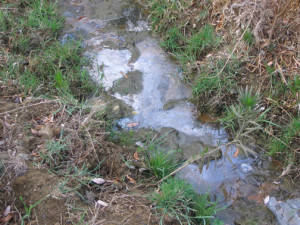
Right she was though we didn’t know at the time what kind of contamination had caused the sheen. It didn’t seem to be a hydrocarbon like gasoline because it didn’t smell anything like it upon closer inspection. For her trouble, Duffield was nicknamed “Hawkeye” by the Radiation Rangers.
According to the developer’s environmental reports that EnviroReporter.com had obtained, all of which are now on the DTSC Runkle Canyon website, no one had tested the creek water for pollutants though that would seem the obvious place to check if lab contamination had flowed downhill into the canyon. And for the Radiation Rangers’ trouble, the group tried and failed to get the city to come test the water with them, Mayor Paul Miller telling the group that the developer had assured the city that it already had tested “surface water” in the canyon.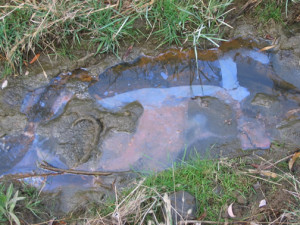
That testing was actually of some water pooled in chunks of asphalt, remnants of the old road leading down from the former sand and gravel mine operated until 1985 by Southern Pacific Milling Company in the western canyon branch of Runkle Canyon. This is a substantial distance from Runkle Canyon Creek. The water tested high for toxins associated with, not surprisingly, asphalt and was deemed not representative of the surface water of the canyon therefore no problem was detected.
Heavy Metal Thunder
The extremely high levels of toxins at the ESADA are no surprise to the Rangers since they acted upon Duffield’s sighting in May 2007 as reported in the Los Angeles CityBeat cover story “The Radiation Rangers.”
Like the ESADA uphill and connected along the Burro Flats Fault, we reported the bad news from the Rangers’ May 2007 Runkle Canyon Creek sampling:
Due to increasing awareness of the lethality of arsenic, the Environmental Protection Agency lowered the “maximum contaminant level” (MCL) for the substance in drinking water from 50 parts per billion (ppb), established in 1975, to 10 ppb in 2001. “A 1999 report by the National Academy of Sciences concluded that the 50 ppb standard did not adequately protect human health,” EPA says in describing its new arsenic rule. “EPA set the new MCL of 10 ppb to protect the public against the effects of long-term, chronic exposure to arsenic in drinking water. The new MCL will decrease non-fatal and fatal bladder and lung cancers and will reduce the frequency of other health effects such as diabetes, developmental problems, gastrointestinal illness, and heart disease.” Arsenic has also been linked to many other non-fatal conditions.
Runkle Canyon’s surface water readings for arsenic are 15 times the MCL for drinking water, over 21,000 times the EPA’s “preliminary remediation goal” and 37,500 times the agency’s “public health goal” for potable water.
The mud sample was laced with arsenic as well, coming in at over 548 times the EPA’s preliminary remediation goal for the contaminant in soil. That amount of the toxin is also 213 percent of the Department of Toxic Substances Control (DTSC) arsenic “field action level,” where further investigation is warranted.
“Of course the city didn’t believe the results so I took them back up Runkle over a month later to sample in the same spots,” says Southwick of the July 2, 2007 retest. Though the city tried to spin the results as better than the Rangers’, they were actually worse as reported in an August 2007 Ventura County Reporter news article “Spin Cycle”:
More alarmingly, the city’s tests came back with an even higher amount of arsenic in the water than the Rangers did. The reading for arsenic, which causes bladder and lung cancers as well as diabetes, developmental problems, gastrointestinal illness and heart disease, was 25 percent higher. That translates to 26,478 times tap water’s PRG and 47,000 times California’s “public health goal” for the toxin in drinking water.
Another regulated heavy metal found by the Rangers in Runkle Canyon water, barium, was detected at levels 233 percent higher than the citizens’ sampling. Nickel came in 33 percent higher and vanadium 55 percent more elevated than the earlier tests. That is 2.8 times the “notification level” which are “health-based advisory levels for chemicals in drinking water … when a chemical is found in or threatens drinking water sources,” according to California’s Office of Environmental Health Hazard Assessment. “When notification levels are exceeded, the drinking water system is required to notify the local governing body of the local agency in which the users of the drinking water reside. If the notification level is exceeded, Department of Health Services recommends that the utility also inform its customers and consumers about the presence of the contaminant and about the health concerns associated with its exposure.”
The impacted water in Runkle Canyon eventually makes its way into the groundwater table Simi Valley uses for 20 percent of its supply which is carefully monitored for such toxins to make sure they fall within regulatory limits before they reach the consumer.
Once DTSC got involved in Runkle Canyon, the definition of what a “water source” was changed. Riley told the city that the department considers what comes out of the “tap” the source.
Rangers on the Ramparts
“When you think of all the people that are going to go hiking around in Runkle Canyon, or walking their dogs like I do mine where they are drinking out of the creek, you’ve really got to get a better handle on what’s going on here,” says Matheney. “First the developer says it tested for the heavy metals but they really hadn’t. Then we go and find all this arsenic and vanadium and nickel and the city doesn’t believe us so they go and sample where we did and their results are worse.
“Now we have a good idea where this stuff is coming from up at the ESADA and it’s fairly sure Boeing and KB Home aren’t going to like hearing about it but that is just tough. We’ve had to fight every inch of the way to hold the high ground here. This information has made us even more determined to make sure that development doesn’t take place on land that may be too contaminated to build on.”
“I think this is a game changer, not only with the ESADA revelations but because of those pipes and barrels tossed offsite at the top of Runkle Canyon,” Southwick adds. “But this isn’t going to stop KB Home from charging ahead, not unless DTSC puts the brakes on and makes sure more testing is done in that creek water and mud, and that groundwater monitoring wells are put in to track the progress of Rocketdyne’s toxic legacy coming down The Hill.”
For more photographs of the ESADA complex and surrounding environs, see the ESADA gallery.and the offsite debris and Area IV outfalls gallery.
24 Years of Award-Winning SSFL/Rocketdyne Reporting
June 1998 – June 2022












Aaah, the money issue. Spot on Constance!
Environmental felons like Boeing need to do the right thing and buy out the Runkle developer, clean that land up to SB990 standards, then convert it to open space once cleaned to SB990 standards.
If one checks out Boeing’s income statement, they will find the polluter has enough greenbacks to handle KB with ease. All corporations have insurance companies, maybe EnviroReporter can obtain the insurance policies?
In fact, the polluter has more than enough to also buy out poisoned Woosley-Dayton where there are similar problems.
Being that Boeing is a contractor of the federal government may have some bearing on who they hide behind when push comes to shove. The buck might be passed back to DOE, NASA, the Defense Department, and etcetera. It might be a good idea to consult with attorneys from NRDC, CBG, and so forth.
IANAL, but couldn’t KB Home sue Boeing for the pollution? I don’t think Boeing has any special protection – SSFL is not a Superfund site, right? Assuming KB Home never gets to develop, they’re going to want to recover their investment somehow.
Unless Boeing simply buys them out to avoid the lawsuit.
Michael,
I’m very surprised to see you didn’t mention Tom Seckington or interview him for this piece. Without him weighing in, this report has much less credibility. For those who don’t know, he’s the DTSC Hydro-geologist who’s been studying groundwater movement at SSFL for (I think) 17 years. I’ve been working and consulting with him for the last 3 years and I find him to be the acknowledged expert on SSFL groundwater as well as one of the most honest people working on this project. He’s been totally dedicated to helping our community.
Perhaps you could do a follow up on this report after you talk to him.
Nice work, Mr. C.
I am frankly alarmed that there is a newish citizens group on the other side of the pass from the wonderful rangers that takes in ‘donations’ from the environmental felon mentioned above in the second comment above. This is something it is hoped will not impact the clean-up effort, but this writer feels otherwise. Do you think you can possibly check out the ‘donation’ history and find out more regarding the frequency and amount of polluter’s contributions? It sure sounds like dirty money is on its way to usurp the Hill’s detox marathon that we know is still in its infantile stages at the moment.
Btw, your good work does not go unnoticed.
The Radiation Rangers rock! Indeed, it would be a grand day if and when Runkle follows the example of Ahmanson and is never allowed to be used for residential space, NEVER EVER. Hats off to Mary Weisbrock who sets the bar high for Hawkeye, Toxic Terry, Good Rev John, and the rest of the crew with Mary’s (and her group, Save Open Space) previous involvement in the saving of Ahmanson Ranch. It looks like Runkle is on the same path (fingers crossed). We are very fortunate to have these wonderful people by the community’s side.
Hopefully, the derisiveness of recent noted in the article above, will come to an end. It’s just plain silly to let the badgering fester on, even though the article’s author is 100% in the right. Hypocrisy has a definition and it is this: “having desirable or publicly approved attitudes, beliefs, principles, etc., that one does not actually possess” — the email exchange with DTSC as mentioned is but one erratic example of many; some of which will most likely be uncovered as time goes by, having known the antics of said local perpetrator. . .
Advice: please focus on your marvelous investigations and don’t stop! You guys are just too valuable to let little things get in your way. The community can see through the pettiness, the fraud, the abuse, the indecency, the injustice. We have your back and we scorn the backstabbers out there be it an errant regulator, a mal-adjusted activist, or an ignorant neighbor. Keep on keeping on!
Michael,
This is truly an amazing piece of investigation that you have done. It seems as if you are now extending your terrific reporting skills into becoming a discovery making geologist. Would that you could also do a similar scientific reporting exploration of the whole SSFL—all 2850 acres. Dream on!
From everything I have been able to read or hear discussed, it certainly seems to me that these underground acquifers and earthquake faults could absolutely be the source of our most scary, on-going and long term contamination nightmares. And, they are frequently described as being “poorly understood”. By comparison,soil sampling and removing dangerous surface contamination may turn out to be child’s play.
I certainly hope that you will keep up your good work in Runkle Canyon, and that you will continue to keep the KB builders paralyzed. So far, you and the Radiation Rangers have been more successful at doing this than even the recession.
When you have some free time, I hope that you will come over to Chatworth Park-South, which is just a few blocks away from where I and over 750 Rockpointe condo owners live. We have an underground water situation here involving the longest 7,000 ft.train tunnel (#26) in the USA,located at the North end of our beautiful Chatsworth Park S. The trains go from the Chatsworth station to Simi Valley.
This train tunnel happens to be located at the Southern end of the Chatsworth geological formation…which, I believe, originates up on the SSFL. We have 4300 gallons of underground water flowing, DAILY, through sump pumps in the tunnel, and being ultimately dumped into Chatsworth Park S., which is slowly being turned into a wetland.
The original Railroad builders ran into this water problem in about 1898, when they were constructing the railroad tracks. That’s how long this problems has been going on. Although the tracks have since been raised, the tunnel still gets flooded during the rainy season.
The Water Quality Board has been contacted, has visited the tunnel, and, they in turn have ordered the Railroad to obtain an NPDS permit to “de-water”. This permit process is pending, and we are all very concerned about radionuclides or toxic contaminants that could possibly be in this water…since it could very likely be flowing down underground all the way from down the Chatsworth Formation,from the SSFL. The railroad is apparently required to do some water testing before they can be granted a permit.
In the meantime, the Rangers and other residents should give you an ACADEMY AWARD.